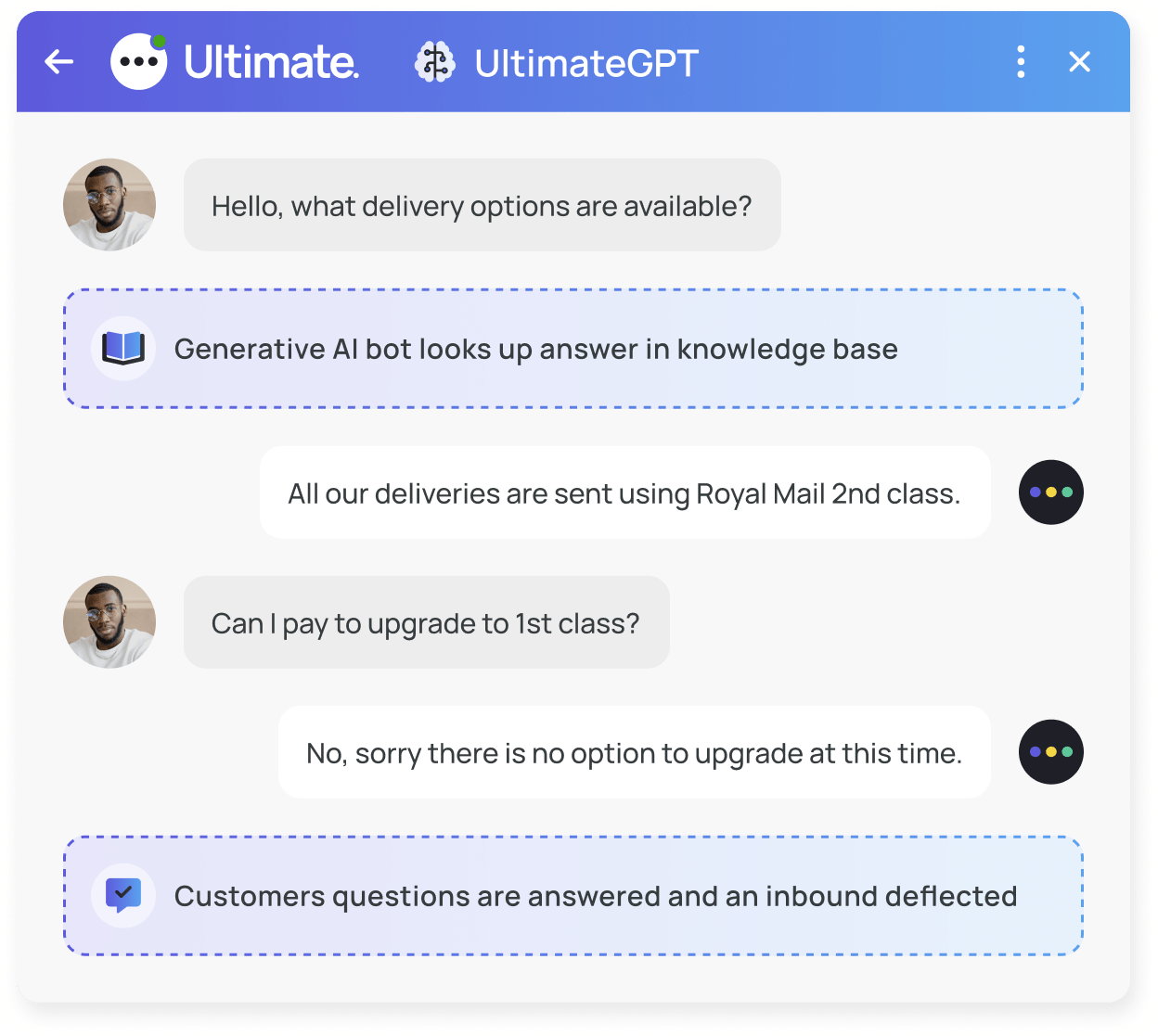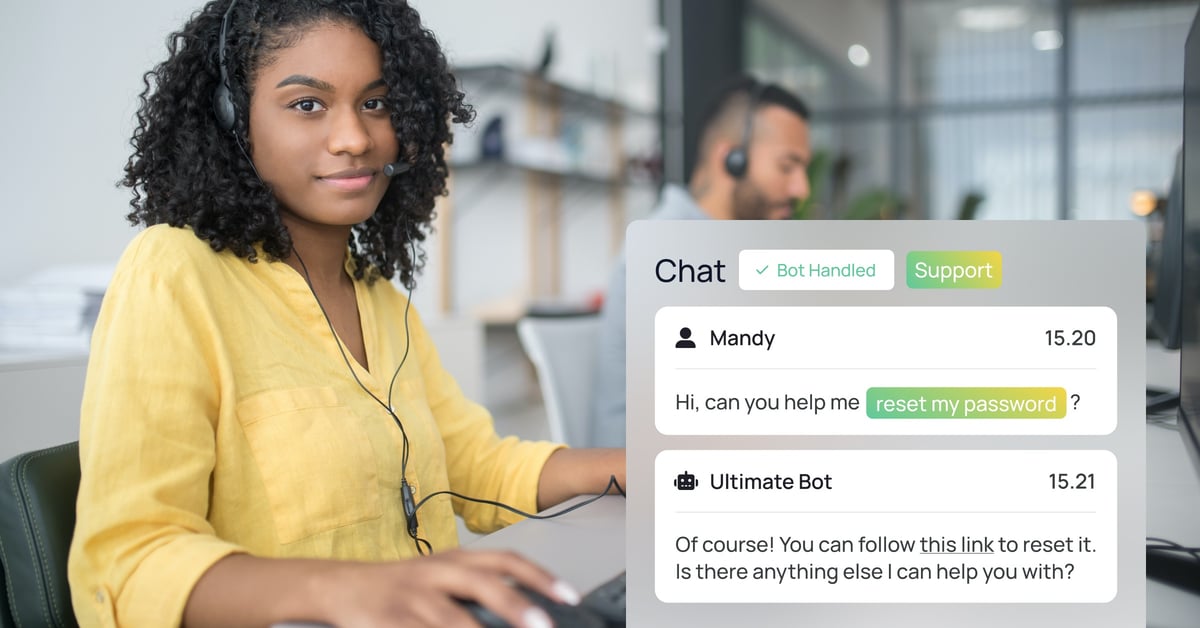We can safely say that ChatGPT is the world’s most famous bot. Everyone and their mother has played around with this generative AI-powered marvel — that can craft poetry, formulate essays, write the script for a fan-fiction sequel to your favorite movie, and more.
The entertainment value of ChatGPT is clear. But the advanced technology behind this clever bot has plenty of applications in the world of work. And business leaders are wondering how to harness this tech to benefit their brand.
ChatGPT for customer service
Customer support is one of the key areas in which ChatGPT is expected to drive the most value for companies. According to McKinsey research, the vast majority of gen AI use cases fall within 4 business functions: Customer operations, marketing and sales, software engineering, and R&D. In fact, approximately 75% of the total value this technology is expected to generate will be see within these areas.
At Ultimate we’re busy building the advanced tech behind ChatGPT into our support automation platform — and if you want to see how it works in practice, check out our UltimateGPT product launch event. But to really understand how generative AI can help level up your support, let’s take a look at some of the top use cases for ChatGPT in customer service.
How ChatGPT works
First — for the non-technical folks here — here’s a quick rundown of how ChatGPT works in simple terms.
As you most likely know, ChatGPT is powered by a branch of artificial intelligence called generative AI. Text-based gen AI bots like ChatGPT are built on large language models, or LLMs. These AI systems are trained on vast amounts of written data — which is why ChatGPT is able to mirror natural human speech so effectively. And what makes these models special is their ability to analyze and weigh the importance of different parts of their training data, in order to create original output.
But LLMs aren’t just useful for generating text. They can process long-form prose to create summaries of the key points, provide translations, analyze the sentiment of a message, and adapt the tone of their responses based on a given prompt — using slang, contractions, and even regional dialect. Ask it for an explanation of Bitcoin in the style of a 1920s New York gangster, or a short story written in Glaswegian dialect (think Trainspotting) and your wish is its command.
Learn more about AI-powered bots
Blog
What Is an NLP Chatbot?
Support Academy
Enterprise Bot Building Best Practices
Top ChatGPT use cases in customer support
Now you know the basics of how ChatGPT works, we’ll take you through some of the most exciting use cases for generative AI in the support sphere.
1. Democratizing bot building
Building a chatbot used to be inaccessible to the vast majority of people. It was a skill that required levels of technical know-how that only software engineers, developers, and AI researchers held. But not anymore. Today just about anybody can build a generative AI chatbot for their customer support.
All you need is two things:
- A text-based source of truth that answers all your FAQs
- An API integration with the LLM powering OpenAI’s ChatGPT
By connecting your pre-existing knowledge base or help center to ChatGPT, you can build a bot in minutes. Yep, it just works — no training or maintenance required. Not only does this mean you’ll see the fastest time to value with automation, but you’ll save on the effort and resources previously dedicated to building out dialogue flows and training the bot. To see the best results, here are some best practices to follow — to get your knowledge base ready for gen AI.
2. Deflecting common support requests
Once your knowledge base bot is up and running, one of the most valuable uses for ChatGPT is deflecting common customer questions. FAQ pages are often not optimized to make it easy for customers to search for the right article to answer their question. And if customers don’t find the answers they need (and quickly) this can lead to frustration and lost business — as well as yet another support ticket in your backlog.

But after connecting ChatGPT to your help center, a generative AI bot can search through your knowledge base articles to find all the answers to common queries. The bot then instantly summarizes and shares this information with customers in a natural, human-like way. This saves your agents from having to answer repetitive inbound requests, so they can save their talents for more complex cases.
Want to try it yourself? Experience the future of support with UltimateGPT.
3. Analyzing and summarizing support conversations
Another area where LLMs excel is in analyzing long customer messages and breaking these down into easily digestible summaries. For an email ticket, this includes removing the noise of signatures and any unnecessary broader context that a customer might provide. The bot can also generate an internal note — allowing agents to quickly understand the reason for contact.
With automated chats as well as tickets, a generative bot can recap and condense an entire conversation before escalating to an agent. This gives your team the context they need to offer faster, more accurate support when a case does need a human touch. As well as this, generative AI can analyze message sentiment, to understand whether a customer is angry or frustrated. This allows the person (or bot) handling the case can adjust their tone accordingly.
4. Suggesting replies
Another area where ChatGPT can support agents in their roles is by generating suggested replies. In this scenario, the gen AI bot acts as a co-pilot for customer support teams. By connecting ChatGPT to your knowledge base or other source of text-based information, the bot can draw on this data to automatically create a suggested response to any incoming support request. Agents can then review this reply, edit as needed, and send it out — meaning faster resolutions and happier customers.
Stay up-to-date on everything to do with ChatGPT, LLMs and gen AI on the Generative AI Hub.
5. Keeping conversations on-brand
ChatGPT’s way with words makes it easier than ever to keep all of your support conversations on-brand. You can ask the LLM bot to adjust the tone of voice it uses to make sure each interaction matches your brand personality. As well as this, you can use further prompts to control the length of bot messages and how they are formatted. This allows for greater personalization of your bot, and a better experience for your customers.
With UltimateGPT, we’ve already released 4 different bot personas: professional, casual, enthusiastic, and informal. Watch the video below to see how it works.
6. Training new support agents
One final exciting use case for gen AI in customer service is onboarding agents to your team. By linking ChatGPT to your internal knowledge base (like a Confluence page) you can create a virtual buddy to answer any questions your new joiners might have. By analyzing commonly asked questions and tracking the bot’s responses, you can also identify where there are gaps in your training materials.
For one of our ecommerce customers, it currently takes them several months to fully onboard new support agents. But with an internal-facing generative AI bot, they’ll be able to cut onboarding times in half. So, for example, a customer based in the UK might ask about sending a product back, outside of the standard returns timeframe. Then instead of searching through documentation around every refund process, new agents can simply ask the bot.
Want to explore more AI use cases? Check out our use case library.
Using generative AI in customer service is still a relatively new phenomenon — but both the popularity of this tech and the wide variety of use cases means it's a trend that's here to stay. And as gen AI matures, the number of ChatGPT use cases for support will continue to expand, making agents’ lives even easier and further improving the customer experience.
